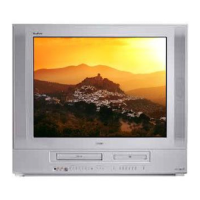Connections and getup
TV(back pane[)
v,ooo0
L@R_(MONO)_ _ COAXlAL(_OPTics-
S-VIDEO INPUT OIJTFtJT! D[GITAL AU[_O
side pane[ (right)
VIDEO
#-
R
Explanation of Jacks and Cables
Your can connect other components to your TV/DVD player such as a VCD, video camera or audio receiver. There are several ways to
connect your other components to your TV/DVD player depending upon the cables you have and the jacks that are on the back of the
components, Different jacks and cables provide a different level of performance, The jacks on the back of your TV/DVD Player and the
cables used to connect them are explained below,
VIDEO
Video Jacks and Cables
VIDEO Jack and Cable
The basic Video jack (usually color-coded yellow) is also referred to as composite video,
Composite video is better than the video quality you get from an RF coaxial cable (the type used
to plug the cable feed into a TV). Usually the video cable is bundled with the audio cables (white
and red),
@
SWmDEO
S-VIDEO Jack and Cable
The S-VIDEO(separate video) jack provides better picture quality than composite video (the
VIDEO jack) because the color is kept separate from the black and white part of the video signal.
Note:RemembertoconnecttheaudiocaD/esbecausetheS-Videocablecarriesonlythepicturesignal,notthesound_
Audio Jacks and Cables
AUDIO L {left) and R {right)
These jacks send the audio from other components to the TV. The audio jacks and cables are
often color-coded (red for right audio, and white for left audio). You must connect audio cables
to the AUDIO L and Rjacks on the TV/DVD Player and the corresponding Audio Input Jacks on
the component no matter which Video jack you connect (VID1 (SVID), DVD, FRONT).
Note: If your component hasonly one fnputfor audio (mona),connect it to the left (white L/Mona)audiojack on the TVand
don't connect the right audiopart of the cable.
6 Connections and Setup

